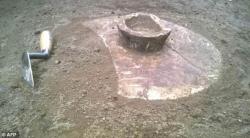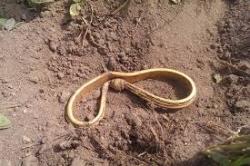INSTITUT SUPERIEUR D'ANTHROPOLOGIE
INSTITUTE OF ANTHROPOLOGY
ONLINE COURSES / COURS A DISTANCE
SUMMER TERM : JULY 2018
REGISTER NOW
EGYPTE –  Kom Ombo - Archaeologists have uncovered a pottery workshop dating back some 4,500 years, officials said Thursday, a rare discovery providing a glimpse into daily life from millenia ago. The find -- which included a stone pottery wheel -- was made close to the southern city of Aswan during work around the Temple of Kom Ombo on the banks of the Nile River, the antiquities ministry said. The workshop was built during the Fourth Dynasty of ancient Egypt (between 2613 and 2494 BC), a statement said, the same period in which the famous pyramids of Giza were constructed. "It is one of the rare finds that sheds light on daily life, industrial activities and the development of art in ancient Egypt," Mostafa Waziri, secretary general of Egypt's Supreme Council of Antiquities, said in the statement. Waziri said the discovery showed "the improvement and adaptation" of tools during the period as people "responded to the demands of daily life".
Kom Ombo - Archaeologists have uncovered a pottery workshop dating back some 4,500 years, officials said Thursday, a rare discovery providing a glimpse into daily life from millenia ago. The find -- which included a stone pottery wheel -- was made close to the southern city of Aswan during work around the Temple of Kom Ombo on the banks of the Nile River, the antiquities ministry said. The workshop was built during the Fourth Dynasty of ancient Egypt (between 2613 and 2494 BC), a statement said, the same period in which the famous pyramids of Giza were constructed. "It is one of the rare finds that sheds light on daily life, industrial activities and the development of art in ancient Egypt," Mostafa Waziri, secretary general of Egypt's Supreme Council of Antiquities, said in the statement. Waziri said the discovery showed "the improvement and adaptation" of tools during the period as people "responded to the demands of daily life".
http://www.dailymail.co.uk/wires/afp/article-5971749/Egypt-archaeologists-4-500-year-old-pottery-workshop.html
EGYPTE –  Alexandrie - A black granite sarcophagus that was discovered earlier this month in Alexandria has been opened in a ceremony attended by Secretary-General of the Supreme Council of Antiquities Mostafa Waziri. Waziri confirmed to Ahram Online that the sarcophagus does not belong to Alexander the Great (356 – 323 BC) as had been speculated by some on social media. A committee from the Ministry of Antiquities has said that the sarcophagus houses the remains of three warriors who appear to have died during battle. The opening had been delayed for three days to water leaks. Waziri said that the date of the sarcophagus has not yet been determined, although early inspection suggests that it dates to the Ptolemaic (332–30 BC) or Roman (30 BC – 642 CE) eras. Shaaban Abdel-Moneim, an expert on mummies, said that the skull of one of the skeletons bears the mark of an arrow wound.
Alexandrie - A black granite sarcophagus that was discovered earlier this month in Alexandria has been opened in a ceremony attended by Secretary-General of the Supreme Council of Antiquities Mostafa Waziri. Waziri confirmed to Ahram Online that the sarcophagus does not belong to Alexander the Great (356 – 323 BC) as had been speculated by some on social media. A committee from the Ministry of Antiquities has said that the sarcophagus houses the remains of three warriors who appear to have died during battle. The opening had been delayed for three days to water leaks. Waziri said that the date of the sarcophagus has not yet been determined, although early inspection suggests that it dates to the Ptolemaic (332–30 BC) or Roman (30 BC – 642 CE) eras. Shaaban Abdel-Moneim, an expert on mummies, said that the skull of one of the skeletons bears the mark of an arrow wound.
http://english.ahram.org.eg/NewsContent/9/40/308226/Heritage/Ancient-Egypt/Recently-discovered-Alexandria-sarcophagus-opened;.aspx
KAZAKHSTAN –  Yeleke Sazy - Ancient golden items have been found in Yeleke Sazy burial ground in the Tarbagatay district of the East Kazakhstan region, said Zainolla Samashev, PhD of historical science. "Golden items have been found in two burial sites Yeleke Sazy in the Tarbagatay mountains in Eastern Kazakhstan. About 3000 golden items have been found dated 7-8 centuries BC related to the Saks epoch, most likely they belonged to noble people," said Z. Samashev. He said there are many jewelries, clothes closing, horses ammunition.
Yeleke Sazy - Ancient golden items have been found in Yeleke Sazy burial ground in the Tarbagatay district of the East Kazakhstan region, said Zainolla Samashev, PhD of historical science. "Golden items have been found in two burial sites Yeleke Sazy in the Tarbagatay mountains in Eastern Kazakhstan. About 3000 golden items have been found dated 7-8 centuries BC related to the Saks epoch, most likely they belonged to noble people," said Z. Samashev. He said there are many jewelries, clothes closing, horses ammunition.
https://www.kaztag.kz/en/news/archeologists-discovered-ancient-treasures-in-east-kazakhstan-region
FRANCE –  Rocamadour - Près d’un siècle après sa découverte (en 1924) par André Niederlender, ancien maire de Rocamadour, et Armand Viré, l’abri Malaurie est le théâtre d’une opération archéologique dirigée par Véronique Laroulandie et Mathieu Langlais, tous deux chercheurs au CNRS à l’université de Bordeaux au sein du laboratoire PACEA. Ce chantier, ouvert en 2017, bénéficie du soutien de la DRAC Occitanie, et de l’aide du département du Lot et de Laurent Clavel de l’Espace Naturel Sensible. Grâce à l’aide de bénévoles étudiant.e.s et passionné.e.s et de chercheurs, l’équipe fouille méthodiquement au pied de l’abri pour mettre au jour quelques silex et restes de faunes, témoignages du passage de nos ancêtres en ces lieux il y a plus de 12 000 ans. Chaque seau de terre est tamisé à l’eau (grâce au prêt d’une tonne par Jean-François Marets). Les refus de tamis seront ensuite triés au laboratoire afin de retrouver les traces les plus discrètes, comme de tous petits ossements brulés. Cette seconde campagne de fouilles a permis de confirmer la présence d’occupations du Laborien, culture de la fin du Paléolithique supérieur définie notamment à partir d’une pointe de flèche en silex dénommée « pointe de Malaurie » reconnue dans d’autres gisements contemporains. Ces chasseurs-collecteurs nomades ont su profiter de la localisation du site, au bord de l’Alzou, pour chasser des cerfs et des chevaux. Les silex exploités indiquent des déplacements sur plusieurs dizaines de kilomètres autour du site et même jusqu’en Charente… Preuve qu’à l’époque déjà, le Haut-Quercy était une terre de rencontres.
Rocamadour - Près d’un siècle après sa découverte (en 1924) par André Niederlender, ancien maire de Rocamadour, et Armand Viré, l’abri Malaurie est le théâtre d’une opération archéologique dirigée par Véronique Laroulandie et Mathieu Langlais, tous deux chercheurs au CNRS à l’université de Bordeaux au sein du laboratoire PACEA. Ce chantier, ouvert en 2017, bénéficie du soutien de la DRAC Occitanie, et de l’aide du département du Lot et de Laurent Clavel de l’Espace Naturel Sensible. Grâce à l’aide de bénévoles étudiant.e.s et passionné.e.s et de chercheurs, l’équipe fouille méthodiquement au pied de l’abri pour mettre au jour quelques silex et restes de faunes, témoignages du passage de nos ancêtres en ces lieux il y a plus de 12 000 ans. Chaque seau de terre est tamisé à l’eau (grâce au prêt d’une tonne par Jean-François Marets). Les refus de tamis seront ensuite triés au laboratoire afin de retrouver les traces les plus discrètes, comme de tous petits ossements brulés. Cette seconde campagne de fouilles a permis de confirmer la présence d’occupations du Laborien, culture de la fin du Paléolithique supérieur définie notamment à partir d’une pointe de flèche en silex dénommée « pointe de Malaurie » reconnue dans d’autres gisements contemporains. Ces chasseurs-collecteurs nomades ont su profiter de la localisation du site, au bord de l’Alzou, pour chasser des cerfs et des chevaux. Les silex exploités indiquent des déplacements sur plusieurs dizaines de kilomètres autour du site et même jusqu’en Charente… Preuve qu’à l’époque déjà, le Haut-Quercy était une terre de rencontres.
https://actu.fr/occitanie/rocamadour_46240/rocamadour-nouvel-abri-cours-fouille_17704077.html